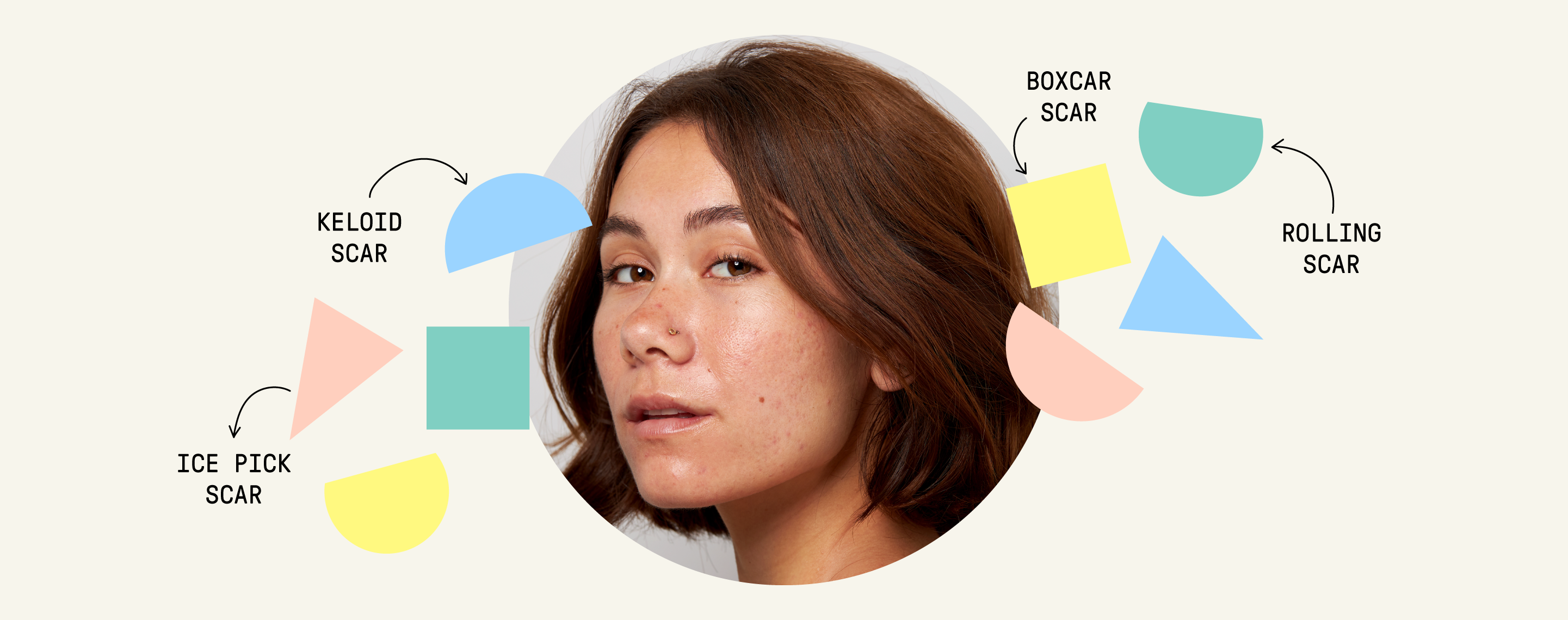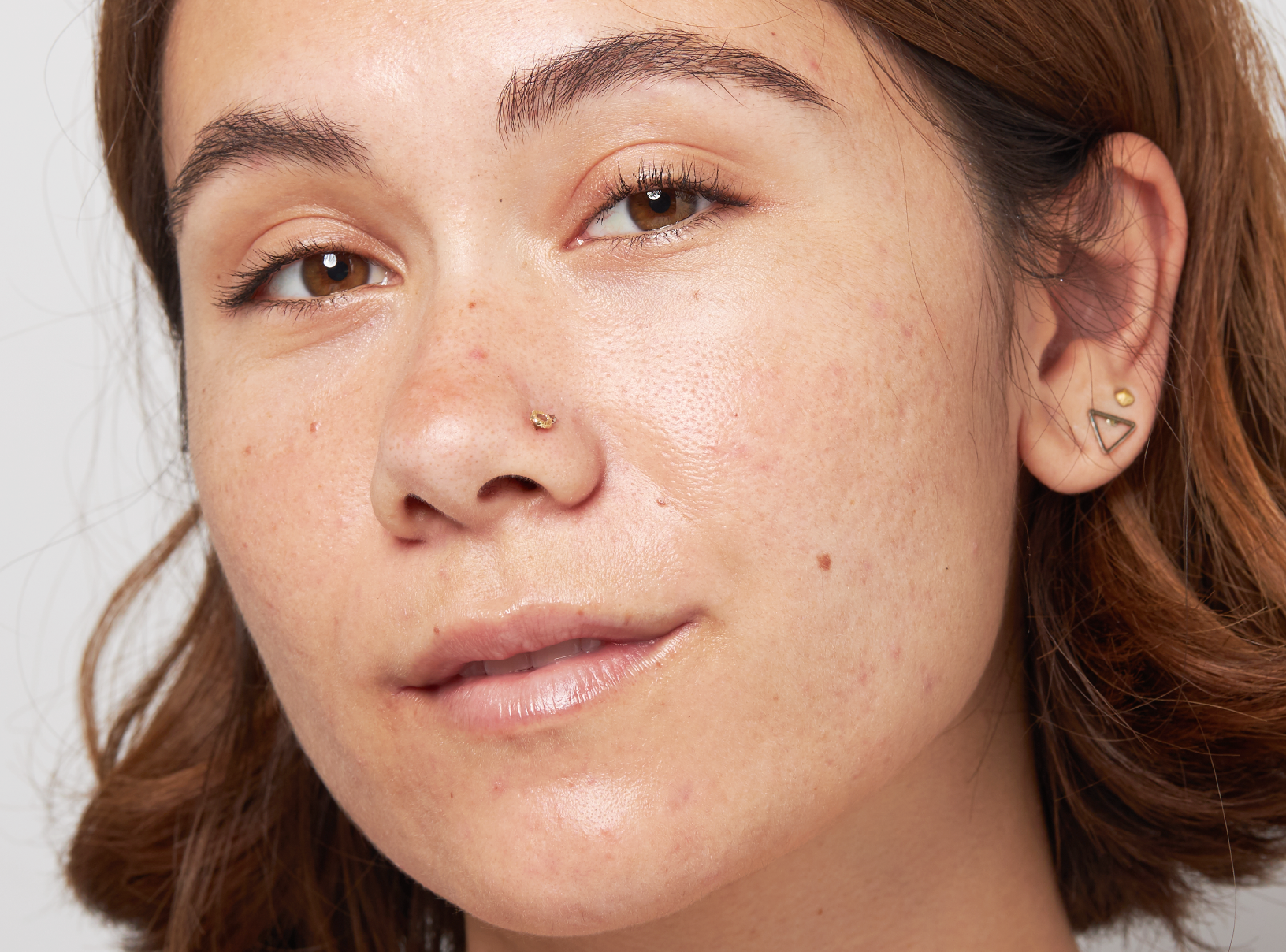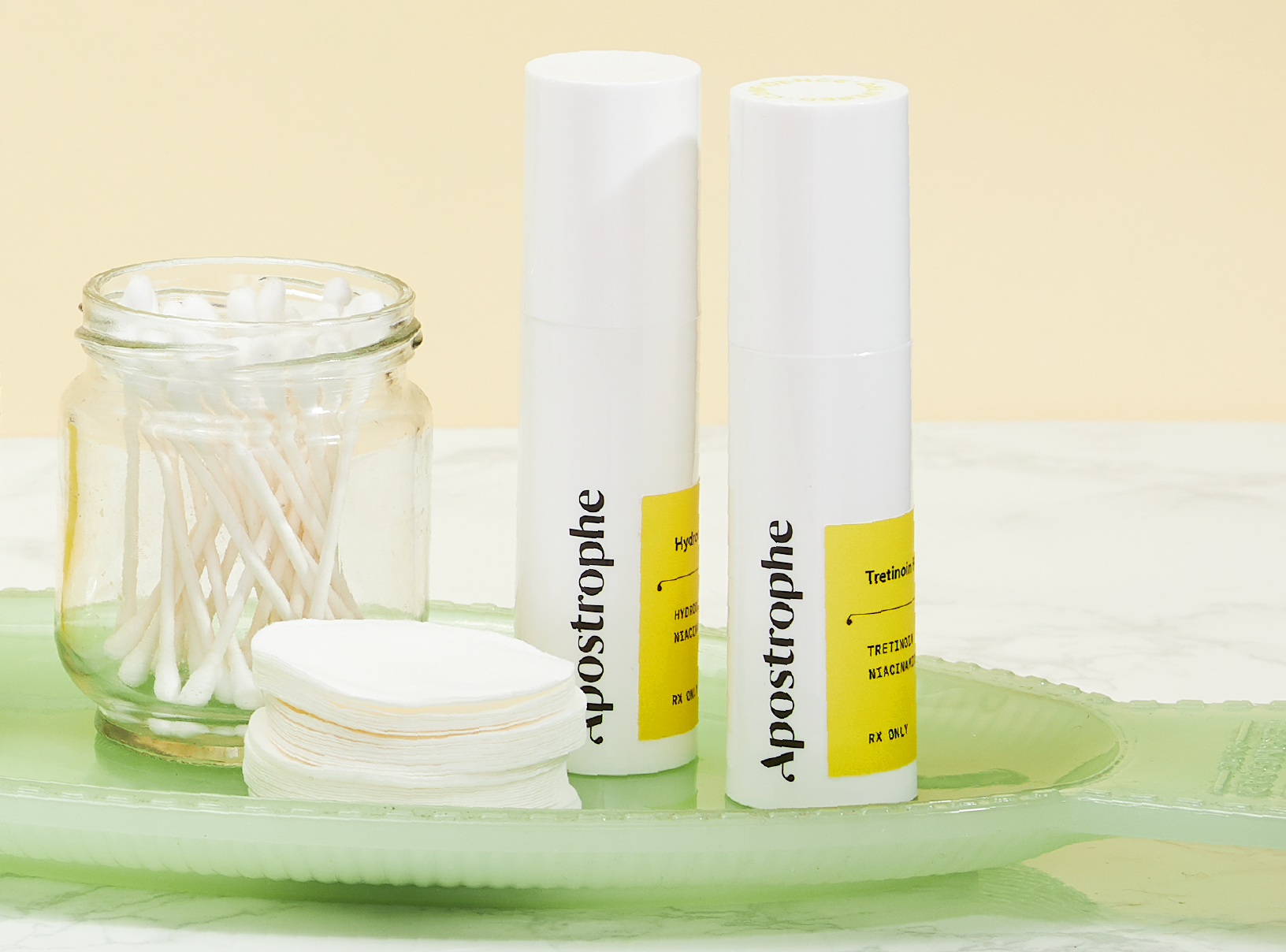Education
The Main Types of Acne Scars & How to Treat Them


SHARE
Education
The Main Types of Acne Scars & How to Treat Them
Medically reviewed by Aimee Paik, MD
Written by Annie Lam
Last updated 4/1/2022
We know acne can be painful, frustrating, and persistent. What’s arguably worse than active breakouts? The scars they leave behind. After experiencing painful acne, many of us are left with stubborn scars as a reminder of our breakouts. Many of us think of acne scars as dark marks and hyperpigmentation, but these aren’t true acne scars because they tend to resolve with time. “Scarring is a permanent change in the skin that does not go away on its own,” explains Dr. Paik, Apostrophe’s medical director. Let’s break down the main types of acne scars:
Types of Acne Scars
Atrophic Scars
The most common type of acne scars is atrophic or depressed scars. “Atrophic scars are depressions left behind after acne is long gone and are common along the temples and cheeks,” explains Dr. Aimee Paik. “These scars sink below the skin’s surface.” These are typically categorized into three different types:
🧊 Ice Pick Scars
Ice pick scars appear as triangular-shaped pits and look like an ice pick has pierced the skin. “These are usually located on the central cheeks, tend to be very small, and are the most difficult to treat”, says Dr. Paik. Ice pick scars form when a breakout comes to the surface and breaks down skin tissue.
📦 Boxcar Scars
Boxcar scars appear as sharp indents in the skin with deep vertical sides. These appear wider than ice pick scars and look like pits on the skin. Boxcar scars form when a pimple breaks down collagen and skin tissue, leaving a depression in the skin from the lack of collagen.
🛼 Rolling Scars
Rolling scars appear as wavy or sloped pits in the skin. These scars make the skin appear uneven and are not as sharp or defined as boxcar scars. Rolling scars form when bands of tissue form between the skin and the subcutaneous tissue underneath it. These bands pull the top layers of the skin downwards, causing a sloped appearance.
Hypertrophic Scars
Hypertrophic scars are raised scars on the skin. These appear as excess scar tissue and can feel hard or firm. Hypertrophic scars occur more commonly at certain body sites such as along the jaw line or on the upper chest and back.
Keloids are a type of hypertrophic scar that is more severe. These are actually able to grow larger than the original wound. Like other hypertrophic scars, keloids form due to an overproduction of collagen in the skin. The tendency to form keloid scars is largely genetic.
Hyperpigmentation & Discoloration
Many people think of stubborn dark or red marks on the skin as “acne scars” but they are actually just surface discoloration. Post-inflammatory erythema (PIE) and hyperpigmentation (PIH) both form after breakouts because of the inflammation caused by acne. Since these spots will fade on their own with time, they are not considered true scars.
Post Inflammatory Erythema (PIE)
Post-inflammatory erythema appears as reddish or purplish marks on the skin that is caused by damaged blood vessels after acne/breakouts. PIE is most common in lighter skin tones but can be found in people of all skin tones.
Post Inflammatory Hyperpigmentation (PIH)
Post-inflammatory hyperpigmentation appears as brown or dark marks on the skin that is caused by increased pigment production after acne/breakouts. PIH is most common in darker skin tones due to the greater amount of melanin in the skin.

CUSTOMIZED HYPERPIGMENTATION TREATMENT
Get customized treatment for your dark spots, melasma, and hyperpigmentation.
How To Treat Acne Scars
Ingredients that treat acne scars
✨ Tretinoin: We all know tretinoin is an all-time favorite treatment for acne, signs of aging, and hyperpigmentation - but Dr. Paik believes it’s also the best topical treatment for acne scars. “Tretinoin can improve atrophic scars by increasing collagen production in the superficial dermis and also helps with cell turnover so post-inflammatory hyperpigmentation can fade more quickly,” she says. “Most importantly, tretinoin prevents new breakouts from forming, thereby preventing further scarring.”
💥 Azelaic Acid: Looking for a gentler, pregnancy-safe option? Azelaic acid is a gentle topical treatment that is an amazing option for fading post-inflammatory hyperpigmentation. Dr. Paik loves azelaic acid because “it has anti-inflammatory and antimicrobial effects, targets comedones, and inhibits pigment production.” Azelaic Acid is a great option for acne-prone and sensitive skin to treat active breakouts and surface discoloration.
⭐️ Hydroquinone: Hydroquinone works by inhibiting melanin production and is used to treat melasma, sun spots, and post-inflammatory hyperpigmentation. It’s one of Apostrophe’s go-to treatments for skin discoloration.
In-office procedures
Another treatment option for acne scarring are in-office procedures like microneedling and lasers but these come with a hefty price tag. When it comes to deciding between a topical treatment or in-office procedures, Dr. Paik recommends waiting before making the investment. “In-office procedures will be more effective for depressed or atrophic acne scars, but unfortunately, they are a lot more expensive—it’s best to make sure your acne is under very good control first before making this investment.”
The best way to get effective treatment for your acne? Work with a board-certified dermatologist from Apostrophe, who will create a custom treatment plan for your unique skin. Topical prescription treatments “are the most effective at keeping acne under control long-term.”
How long does it take to treat acne scars?
Now that we know how to treat acne scars - how long does it take to treat them? And the answer is… it depends! There are a variety of different factors to consider: the severity of your scars and what type of scar it is. What's important to remember is that treating scarring takes time and getting your acne under control comes first.
“If your acne is severe, it can take 6-12 months to get your acne under control using prescription medications,” says Dr. Paik. “Once your acne is under control, you may have scarring that remains.” Here’s how long (on average) it can take to treat the different types of acne scars:
Atrophic Acne Scars (1-2 years): If using tretinoin regularly, it can take 1-2 years to build up collagen and improve the appearance of these atrophic scars.
Hypertrophic Acne Scars (1-2 years): These raised scars can improve and flatten out with time, usually around 1-2 years.
PIE & PIH (6-12 months): Surface discoloration like PIE & PIH typically takes anywhere from 6-12 months to fade depending on severity.
Most importantly? Don't forget sunscreen! Daily sun protection is crucial to preventing hyperpigmentation from getting worse. If you're looking for the perfect acne-safe sunscreen, check out 'Screen - Apostrophe's derm-approved SPF!

HYPERPIGMENTATION TREATMENT
Target dark spots and hyperpigmentation with customized prescription treatment.
We know acne and scarring can be stubborn and frustrating, but being patient with your skin and consistent with your treatments can go a long way. If you’re looking for support along your skincare journey, we recommend getting expert treatment from a board-certified dermatologist. They’ll be with you every step of the way to treat your acne and scarring. Get started on your journey to clear skin today!
Sources:
https://www.ncbi.nlm.nih.gov/pmc/articles/PMC3780804/
https://www.verywellhealth.com/types-of-acne-scars-15812
Shop this post

Tretinoin

Hydroquinone

Finacea (azelaic acid)
Like what you just read? Sign up for our email list to get the scoop on skincare science delivered straight to your inbox.

Education
What is milia?
What is milia? Today, we’re jumping into one type of bump that you may have heard about most commonly in infants — milia.
Read More
Education
Best moisturizer for acne-prone skin
If you have combination acne-prone skin, figuring out which moisturizer is best for your skin might be tough. In this guide, we break down the best moisturizer for combination, acne-prone skin.
Read More
Education
How to build a face care routine
As you get into skincare, it might seem overwhelming, especially trying to figure out the order you're supposed to apply products in. Below, we detail how to build a face care routine for your skin!
Read More